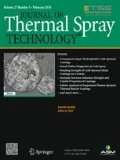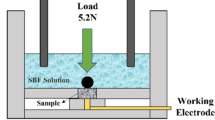Abstract
A set of yttria partially stabilized zirconia coatings with different thickness was deposited on flat nickel-base alloy coupons by air plasma spray (APS) under uncontrolled temperature conditions. In this way, the length of the spraying process (and consequently the coating thickness) had a direct effect on phase composition as well as on the thermal properties of the material. In particular, both the monoclinic phase percentage and thermal diffusivity increased considerably with the thickness. Because this trend was observed together with a slight but clearly visible increase in the total porosity, the interpretation of the results was not straightforward, but required a detailed discussion of the thermal transport mechanism. Considering the complex microstructure typical of APS coatings and the relevant role of porosity, it was shown how a modest reduction in the fraction of closed pores can account for the observed increase in diffusivity. It was then proposed that the volume change associated with the progressive tetragonal to monoclinic phase transformation can be responsible for the reduction of the closed porosity of lenticular shape oriented parallel to the surface, in spite of the observed increase in the total porosity.
Similar content being viewed by others
References
V.P. Swaminathan and N.S. Cheruvu, Gas Turbine Hot-Section Materials and Coatings in Electric Utility Applications, Advanced Materials and Coatings for Combustion Turbines, V.P. Swaminathan and N.S. Cheruvu, Ed., ASM International, 1994
Proc. Quadriennial International Conf. Power Stations, 13–15 Oct 1997, Association Ingenieurs de Montflory, 1997
M.G. Hocking, V. Vasantaree, and P.S. Sidky, Metallic & Ceramic Coatings: Production, High Temperature Properties & Applications, Longman Scientific & Technical, Harlow, Essex, UK, 1989
P. Scardi, M. Leoni, and L. Bertamini, Residual Stress in Plasma Sprayed Partially Stabilised Zirconia TBCs: Influence of the Deposition Temperature, Thin Solid Films, Vol 278, 1996, p 96–103
L.C. Aamodt, J.W. Maclachlan Spicer, and J.C. Murphy, Analytical of Characteristic Thermal Transit Times for Time-Resolved Infrared Radiometry Studies of Multilayered Coatings, J. Appl. Phys., Vol 68 (No. 12), 1990, p 6087–6098
D.P. Almond and P.M. Patel, Photothermal Science and Techniques, Chapman & Hall, London, 1996
L. Fabbri, F. Cernuschi, P. Fenici, S. Ghia, and G.M. Piana, Photothermal Techniques for Nondestructive Characterisation of Turbine Blade Coatings, Materials for Advanced Power Engineering, Part II, D. Coutsouradis et al., Ed., Kluwer Academic, Dordrecht, The Netherlands, 1994, p 1377–1381
G. Busse and H.G. Walther, Photothermal Nondestructive Evaluation of Materials with Thermal Waves, Progress in Photothermal and Photoacoustic Science and Technology, Vol 1, Principles and Perspectives of Photothermal and Photoacoustic Phenomena, A. Mandelis, Ed., Elsevier Science, 1992, p 218–222
Technical bulletin No. 10.311, Metco Inc., Westbury, NY 1985
P. Scardi, L. Lutterotti, and P. Maistrelli, Experimental Determination of the Instrumental Broadening in the Bragg-Brentano Geometry, Powder Diffr., Vol 9 (No. 3), 1994, p 180–186
M. Leoni and P. Scardi, A Computer Program for Structural Refinement from Thin Film XRD Patterns, Mater. Sci. Forum, Vol 278–281, 1998, p 177–182
B. Shultz, Thermal Conductivity of Porous and Highly Porous Materials, High Temp.-High Press., Vol 13, 1981, p 649–660
D.S. McLachlan, An Equation for Conductivity of Binary Mixtures with Anisotropic Grain Structures, J. Phys. C: Solid State Phys., Vol 20, 1987, p 865–877
A.D. Brailsford and K.G. Major, The Thermal Conductivity of Aggregates of Several Phases, Including Porous Materials, Br. J. Appl. Phys., Vol 15, 1964, p 313–319
A. Bjorneklett, L. Haukeland, J. Wigren, and H. Kristiansen, Effective Medium Theory and the Thermal Conductivity of Plasma-Sprayed Ceramic Coatings, J. Mater. Sci., Vol 29, 1994, p 4043–4050
R. McPherson and B.V. Shafer, Interlamellar Contact within Plasma-Sprayed Coatings, Thin Solid Films, Vol 97, 1982, p 201–204
Author information
Authors and Affiliations
Rights and permissions
About this article
Cite this article
Cernuschi, F., Bianchi, P., Leoni, M. et al. Thermal diffusivity/microstructure relationship in Y-PSZ thermal barrier coatings. J Therm Spray Tech 8, 102–109 (1999). https://doi.org/10.1361/105996399770350629
Received:
Revised:
Issue Date:
DOI: https://doi.org/10.1361/105996399770350629




